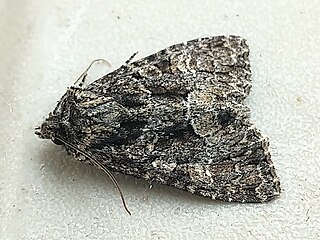
Platypolia mactata, the adorable brocade, is a species of cutworm or dart moth in the family Noctuidae. It is found in North America.
Condica temecula is a species of moth in the family Noctuidae. It was first described by William Barnes in 1905 and it is found in North America.
Acronicta dolli, or Doll's dagger moth, is a species of moth in the family Noctuidae. It was first described by William Barnes and James Halliday McDunnough in 1818 and it is found in North America.
Dichagyris kyune is a species of cutworm or dart moth in the family Noctuidae. It was first described by William Barnes in 1904 and it is found in North America.
Lacinipolia viridifera is a species of cutworm or dart moth in the family Noctuidae. It is found in North America.
Dichagyris lobato is a species of cutworm or dart moth in the family Noctuidae. It was first described by William Barnes in 1904 and it is found in North America.

Heterocampa biundata, the wavy-lined heterocampa, is a species of moth in the family Notodontidae. It was first described by Francis Walker in 1855 and it is found in North America.
Sympistis piffardi, the three-striped oncocnemis, is a species of moth in the family Noctuidae. It is found in North America.
Datana robusta, the annual buttonweed or robust datana moth, is a species of moth in the family Notodontidae. It was first described by Herman Strecker in 1878 and it is found in North America.
Sigela eoides, the youthful sigela moth, is a species of moth in the family Erebidae. It was first described by William Barnes and James Halliday McDunnough in 1913 and it is found in North America.
Ponometia pulchra is a species of bird-dropping moth in the family Noctuidae. It was first described by William Barnes and James Halliday McDunnough in 1910 and it is found in North America.
Oligocentria alpica is a species of moth in the family Notodontidae. It was first described by Foster Hendrickson Benjamin in 1932 and it is found in North America.
Supralathosea pronuba is a species of mossy sallow in the family of moths known as Noctuidae. It was first described by William Barnes and James Halliday McDunnough in 1916 and it is found in North America.
Anarta inconcinna is a species of cutworm or dart moth in the family Noctuidae. It was first described by Smith in 1888 and it is found in North America.
Deinopa angitia is a species of moth in the family Erebidae first described by Herbert Druce in 1891. It is found in Central and North America.
Zale bethunei, or Bethune's zale, is a species of moth in the family Erebidae first described by Smith in 1908. It is found in North America.
Lacinipolia aileenae is a moth genus or species of cutworm or dart moth in the family Noctuidae. It is found in North America.
Stylopoda modestella is a species of moth in the family Noctuidae. It was first described by William Barnes and James Halliday McDunnough in 1918 and it is found in North America.
Lacinipolia spiculosa is a species of cutworm or dart moth in the family Noctuidae. It is found in North America.

Paectes pygmaea, the pygmy paectes, is a moth in the family Euteliidae. The species was first described by Jacob Hübner in 1818. It is found in North America.



